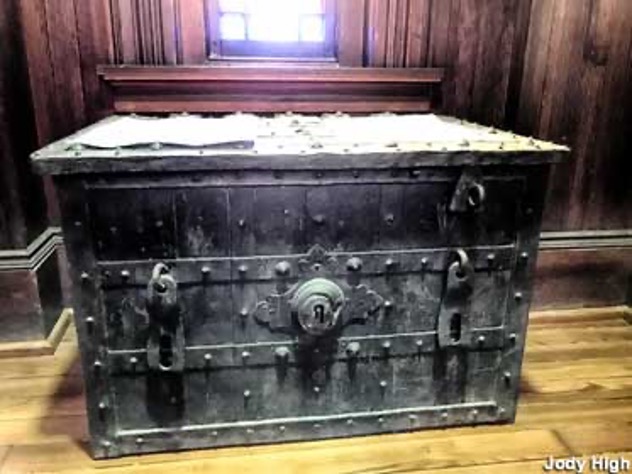General Robert Lee sent an urgent message to Jefferson Davis on 2 April 1865 to take the Confederate Gold and leave Richmond; Union Troops were moving toward them. The Confederates burned 35 blocks of Richmond and departed for Danville, Virginia. Navy Captain William Parker was in charge of the gold transportation. The Confederate Gold included: all the gold, silver, treasures, 39 kegs of Mexican silver dollars from the sale of cotton to Mexico, important papers of the Confederacy, jewelry donated by the women throughout the war and the money from the banks in Richmond. Two trains were loaded, the first train carried Davis and his cabinet. The second train carried the Confederate Gold.
The Confederate Gold traveled by train or wagon depending upon the availability of a train. The route traveled from Richmond, VA, was to: Danville, VA; Greensboro, NC; Charlotte, NC; Chester, SC; Newberry, SC; Abbeville, SC; Washington, GA; Augusta, GA; Washington, GA; Abbeville, SC to Washington, GA.
When fleeing through the Carolinas, the gold was stored in the Charlotte Mint. Gold was first discovered in America in 1799 on Little Meadow Creek, 50 miles from Rock Hill, now known as Reed Gold Mine. Later, gold was discovered in York County with 48 mines in the north-west corner of York County, active from 1829-1942, and several around the Catawba River. Gold mining was second only to farming in this area.
The Federal Government built the first United States Branch Mint in Charlotte in 1837 to process the large amount of gold. Mint mark was C. Prior to the Charlotte Mint, gold was shipped to Great Britain or carried to Philadelphia to mint. Transportation and safety on the Great Wagon Road to Philadelphia was a concern.
The Charlotte Mint was seized by the Confederacy in 1861 and converted to a hospital. During Reconstruction, Federal Troops occupied the Mint. In 1931, the Mint was acquired by a group of private citizens and relocated from West Trade Street to Randolph Road in Charlotte. It became the Mint Museum of Art, the first Art Museum in North Carolina. The Charlotte Mint minted its last coins in 1861 before the Civil War.
The Bechtler Family from Germany operated a private mint in Rutherford County, North Carolina, before the Charlotte Mint was established. Some Bechtler family descendants now live in Rock Hill.
Opening of the Mints:
1792 Philadelphia
1832 Bechtler
1837 Charlotte
California Gold Rush: 1848
The gold stored in the Charlotte Mint was loaded on April 8th 1865 onto a train traveling through Fort Mill and Rock Hill bound for Chester. Mrs. Jefferson Davis, children and companions joined this train in Charlotte. From Chester the gold was loaded onto wagons to Newberry, SC. Mrs. Davis and her group rode in wagons. All men and officers walked. Recent heavy rains bogged down the wagons. Mrs. Davis with her group walked six miles to the Woodward Baptist Church in Chester where they slept on the pews of the church on April 13, 1865. A gold coin with a mint date of 1851 was found in Chester in the 1930s.
What happened to the Lost Confederate Treasure?
Beliefs, rumors, legends, theories and stories abound but the truth remains a mystery. Two movies have been made about the lost gold: The Good, The Bad and the Ugly with Clint Eastwood and Sahara.
The biggest story is that the Confederate riches are buried in the city-owned cemetery in Danville, Virginia. The City refuses to allow anyone to dig in the cemetery. Testing has determined that there are objects buried there. Some of the Mexican silver dollars have turned up in Danville over the years.
In the 1940s, a logging crew unearthed a Mexican silver dollar dated in the 1850s in an area in Georgia where Jefferson Davis had camped. They “lightened ship” along the way by throwing away books, stationery and perhaps confederate money. Their route was traced by the discards.
One story recorded as TRUE: President Davis left a box with a lady who lived near a pontoon bridge across the Savannah saying it was too heavy to carry. She opened it when they left and found it full of jewelry. She was so concerned that she buried the box in her garden. Several days later a man returned saying that Jefferson Davis had sent him to retrieve the box. She gave it to him and no one ever saw the box again. This was believed to be the jewelry that the women had donated to help the Confederate cause.
The Fourth Michigan Cavalry captured Jefferson Davis in Irwinville, Georgia, on May 10, 1865.
Davis had only a few dollars in his pocket but another story was born. The story goes that the gold was taken to Michigan on a ferry. The crew had to push the gold overboard during a heavy storm. The idea that millions of dollars’ worth of historic gold is at the bottom of a lake has tempted many a treasure hunter.
The belief that Confederate gold is buried in Wilkes County, Georgia, has persisted since the end of the war. Somewhere in Wilkes County the wagon train was bushwhacked and the bushwhackers “waded knee-deep in gold and silver.” Serious searches have been conducted throughout the years and nothing has ever been found of the Confederate Gold in Wilkes County.
Rumor has it that many gold coins have been found along the dirt roads near Chennault Plantation in Georgia along the route of the Confederate Gold.
The loss of the Confederate Gold keeps fortune-hunters and historians up at night.

